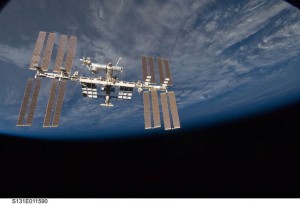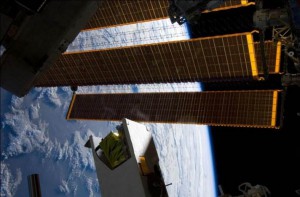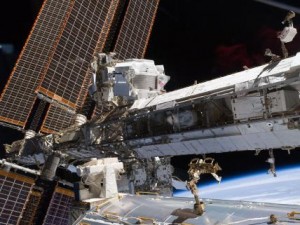
The International Space Station nears 13 years of continuous staffing by astronauts. Photo Credit/NASA
As though she was counting down a space mission launch, NASA International Space Station program scientist Julie Robinson has been running through her list of top 10 science achievements carried out aboard the six person orbiting science lab with a series of blogs.
The station has been continuously staffed by U. S.and Russian astronauts since Nov. 2, 2000. Assembly of theU. S.segment, started in late 1998, was completed in 2011. Currently, operations are planned through 2020, though NASA would like to extend activities through 2028. Sixty nine countries have participated in station research so far.
Robinson’s series of “Top 10″ daily blogs (http://blogs.nasa.gov/ISS_Science_Blog) began Oct. 18.
But she rolled out the entire list in September at the 64th International Astronautical Congress in Beijing, China.
“Early explorers traveled the world to exploit economic opportunities, not to inspire their children about it,” said Robinson, as she opened the presentation. “Explorers responsible for pushing the boundaries and the scientists follow behind.”
Robinson’s Top 10 is presented below in reverse order to preserve some of her suspense.
No. 10: Astronauts are now able to stave off much of the bone loss that has historically accompanied long periods of weightless during spaceflight. Proper diet, including adequate amounts of vitamin D, and exercise are the solution. Resistive exercise, like that afforded by weight lifting on the Earth, is a recent addition and is now helping to prevent a similar terrestrial ailment, osteoporosis.

NASA astronaut Lee Archambault works out with the Advanced Resistive Exercise Device aboard the space station. Photo Credit/NASA Photo
No. 9: Understanding the metabolic processes that lead to osteoporosis and developing the medications and therapies for prevention.
No. 8: Using optical instruments on the space station to assess water quality in the world’s coastal bays.
No. 7: Manipulating nanoparticles with electrical fields through the self assembly of colloids. Paint and milk are examples of liquids with particles called colloids.
No. 6: Combustion research that is revealing more efficient ways of fuel consumption.
No. 5: Studies that reveal increased virulence of bacteria in space. The findings point to possible vaccines, perhaps one to combat salmonella, which is responsible for 15,000 hospitalizations and 400 deaths annually.

Instruments aboard the space station study the water quality in the world's coastal bays. Photo Credit/NASA Photo
No. 4: Activities that inspire and instruct students about the values of science, technology, engineering and math, or the STEM fields. Space station crews and other activities have involved 63 million of the world’s students so far.
No. 3: Studies of dark matter using the Alpha Magnetic Spectrometer, an external observatory that was installed by space shuttle astronauts in 2011. Much of the universe is made of dark matter, a substance that scientists are just beginning to understand.

Alpha Magnetic Spectrometer, top center, monitors cosmic rays from the space station solar power truss. Photo Credit/NASA Photo
No. 2: Improvements in robotics accomplished with the station’s Canadian built robot arms that are leading to improvements in brain surgery techniques.
No. 1: Microgravity micro-encapsulation. The term is a mouthful, but it means using the weightless environment to develop drugs that can attack specific tumors with chemotherapy. Medical trials are under way.

